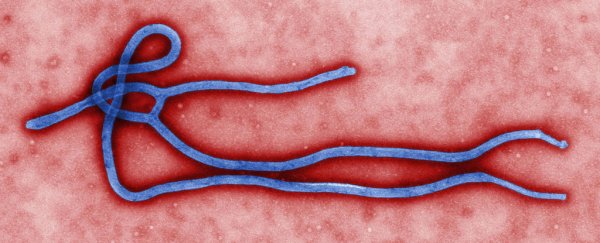Ebola is a rare disease impacting humans and other primates. It's caused by a group of viruses within the genus Ebolavirus, and it's known for being highly fatal if untreated.
Past outbreaks have seen anywhere from 25 to 90 percent of those infected dying as a result of the disease's worst symptoms, which usually progress from flu-like lethargy and fever, to abdominal pain, nausea and vomiting, diarrhoea, shortness of breath, headaches, and chest pain.
In roughly half of cases, a bumpy rash appears within the first week of infection. Mild to moderate bleeding through skin breaks and mucus membranes is also reported in just under half of all cases as a result of reduced blood clotting.
How does ebola kill you?
When death occurs from ebola, it's typically the result of fluid lost through vomiting and diarrhoea, or blood loss in extreme cases.
There are four species of virus in the Ebolavirus genus capable of infecting and causing disease in humans. They are all RNA viruses in a larger family known as filoviruses, which tend to replicate easily in a diverse range of cells in the human body.
The virus is transmitted between hosts via bodily fluids, either through direct contact or by touching contaminated objects. The infectious viral particles are then transferred into the body through breaks in the skin or membranes in the nose, mouth, or eye.
Cells that line organs and blood vessels are among the first to be infected. They are then quickly damaged by chemicals produced by the virus, which cause the vessels to leak. Combined with a breakdown in blood clotting, these changes are responsible for some of the disease's worst symptoms.
Early treatment with ample fluids has so far been the only way to reduce the risk of dehydration and death. There are experimental drugs in development that could lower fatalities to roughly 5 percent, and vaccines being trialled that could reduce the number of infections.
Where did ebola come from?
The first recognised outbreak of Ebola occurred in what is now The Democratic Republic of Congo in 1976, near the eponymous Ebola River. It resulted in 318 cases, of which 218 individuals died.
Since then, there have been numerous outbreaks and epidemics resulting in thousands of casualties. The World Health Organisation has classified the most recent ongoing outbreak in Congo, which started in 2018, a public health emergency of international concern.
We're still not sure how this virus actually showed up in humans, although evidence points to new encounters with animal reservoirs such as isolated bat populations, which could have created a bridge for the virus to reach us.
All topic-based articles are determined by fact checkers to be correct and relevant at the time of publishing. Text and images may be altered, removed, or added to as an editorial decision to keep information current.
